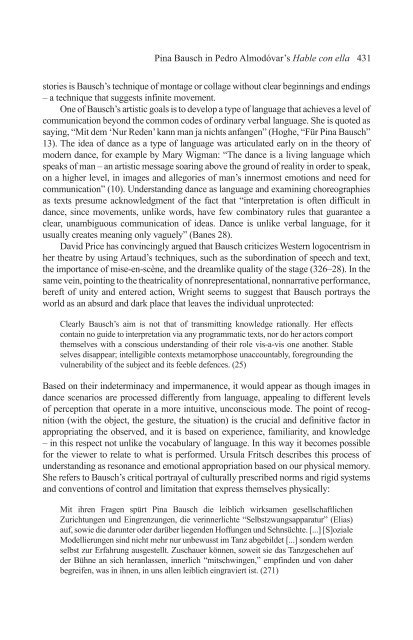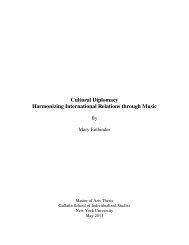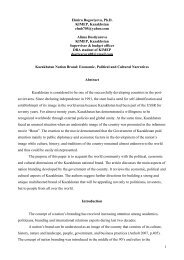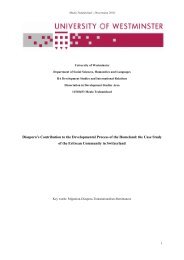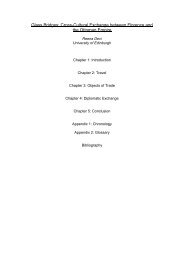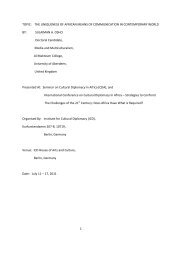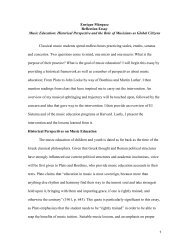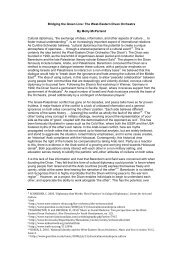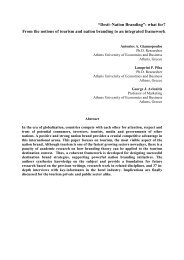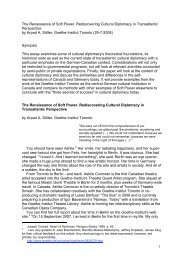Hable con ella - Institute for Cultural Diplomacy
Hable con ella - Institute for Cultural Diplomacy
Hable con ella - Institute for Cultural Diplomacy
You also want an ePaper? Increase the reach of your titles
YUMPU automatically turns print PDFs into web optimized ePapers that Google loves.
Pina Bausch in Pedro Almodóvar’s <strong>Hable</strong> <strong>con</strong> <strong>ella</strong> 431<br />
stories is Bausch’s technique of montage or collage without clear beginnings and endings<br />
– a technique that suggests infinite movement.<br />
One of Bausch’s artistic goals is to develop a type of language that achieves a level of<br />
communication beyond the common codes of ordinary verbal language. She is quoted as<br />
saying, “Mit dem ‘Nur Reden’ kann man ja nichts anfangen” (Hoghe, “Für Pina Bausch”<br />
13). The idea of dance as a type of language was articulated early on in the theory of<br />
modern dance, <strong>for</strong> example by Mary Wigman: “The dance is a living language which<br />
speaks of man – an artistic message soaring above the ground of reality in order to speak,<br />
on a higher level, in images and allegories of man’s innermost emotions and need <strong>for</strong><br />
communication” (10). Understanding dance as language and examining choreographies<br />
as texts presume acknowledgment of the fact that “interpretation is often difficult in<br />
dance, since movements, unlike words, have few combinatory rules that guarantee a<br />
clear, unambiguous communication of ideas. Dance is unlike verbal language, <strong>for</strong> it<br />
usually creates meaning only vaguely” (Banes 28).<br />
David Price has <strong>con</strong>vincingly argued that Bausch criticizes Western logocentrism in<br />
her theatre by using Artaud’s techniques, such as the subordination of speech and text,<br />
the importance of mise-en-scène, and the dreamlike quality of the stage (326–28). In the<br />
same vein, pointing to the theatricality of nonrepresentational, nonnarrative per<strong>for</strong>mance,<br />
bereft of unity and entered action, Wright seems to suggest that Bausch portrays the<br />
world as an absurd and dark place that leaves the individual unprotected:<br />
Clearly Bausch’s aim is not that of transmitting knowledge rationally. Her effects<br />
<strong>con</strong>tain no guide to interpretation via any programmatic texts, nor do her actors comport<br />
themselves with a <strong>con</strong>scious understanding of their role vis-a-vis one another. Stable<br />
selves disappear; intelligible <strong>con</strong>texts metamorphose unaccountably, <strong>for</strong>egrounding the<br />
vulnerability of the subject and its feeble defences. (25)<br />
Based on their indeterminacy and impermanence, it would appear as though images in<br />
dance scenarios are processed differently from language, appealing to different levels<br />
of perception that operate in a more intuitive, un<strong>con</strong>scious mode. The point of recognition<br />
(with the object, the gesture, the situation) is the crucial and definitive factor in<br />
appropriating the observed, and it is based on experience, familiarity, and knowledge<br />
– in this respect not unlike the vocabulary of language. In this way it becomes possible<br />
<strong>for</strong> the viewer to relate to what is per<strong>for</strong>med. Ursula Fritsch describes this process of<br />
understanding as resonance and emotional appropriation based on our physical memory.<br />
She refers to Bausch’s critical portrayal of culturally prescribed norms and rigid systems<br />
and <strong>con</strong>ventions of <strong>con</strong>trol and limitation that express themselves physically:<br />
Mit ihren Fragen spürt Pina Bausch die leiblich wirksamen gesellschaftlichen<br />
Zurichtungen und Eingrenzungen, die verinnerlichte “Selbstzwangsapparatur” (Elias)<br />
auf, sowie die darunter oder darüber liegenden Hoffungen und Sehnsüchte. [...] [S]oziale<br />
Modellierungen sind nicht mehr nur unbewusst im Tanz abgebildet [...] sondern werden<br />
selbst zur Erfahrung ausgestellt. Zuschauer können, soweit sie das Tanzgeschehen auf<br />
der Bühne an sich heranlassen, innerlich “mitschwingen,” empfinden und von daher<br />
begreifen, was in ihnen, in uns allen leiblich eingraviert ist. (271)


